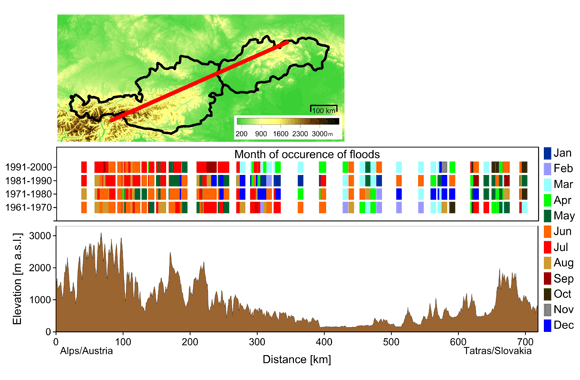News
AGU "Editor's Citation for Excellence in Refereeing" awarded to TU Wien Researcher
Dr. Rui A. P. Perdigão, researcher at TU Wien and Flood Change team member, was distinguished by the American...
Symposium "Land Use Change Impacts on Floods"
In October 2014 the Flood Change Team of the Technical University of Vienna organised a Symposium with the aim...
Symposium "Deciphering River Flood Change: Historical Floods"
In 2013 another workshop was organised in the framework of the ERC project "FloodChange" in the...
Project Idea
We use the concept of process types, such as flash floods, rain-on-snow floods, snow melt floods and large scale synoptic floods, as a common currency to systematise floods and address the key questions in the following way:
When, where, how have floods changed?
Trend analyses in the literature have found little consistency on whether floods have increased or decreased. We are developing new indicators to detect changes in floods that are based on the flood types as well as the time of the year the floods occur, their spatial coherence, catchment soil moisture and land use. Since the indicators identify the flood generating processes they are expected to be more powerful for detecting change than flood magnitudes alone. We will use these new indicators to detect changes in flood characteristics in European catchments.

Why do floods change?
The exact causes of river flood changes are still a mystery. Although, drivers such as climate and land use change are known to play a critical role, their complex interactions have not been disentangled. We will separately analyse floods in catchments where climate variability is large and land use changes are small, and where the opposite is the case, and will account for the dominant mechanisms of change in flood modelling. The impact of this will be to enable isolation of individual factors contributing to changes in floods for a given flood process type, and make the change mechanisms transparent.

How sensitive are floods to changes in land use and climate?
The current approach of assessing how floods will change for a given change in climate or land use consists of model-based scenario analyses. However, it is unclear how accurate the model based approach is. For this reason we will add two independent methods that are based on the temporal and spatial variability of flood data. The impact of this will be to enhance the reliability of the estimated sensitivities of floods to changes in the drivers. Understanding the sensitivities is extremely useful for predicting the impact of future climate and land use changes on floods.

How confident can we be about predicting future changes in floods?
The robustness of estimated flood changes is unknown at present. We will combine the results from three complementary sensitivity methods to understand the parameters that control the uncertainty of flood change predictions. The impact of understanding the sources and magnitude of uncertainties in a unified way will be to provide a major step towards more robust predictions of how floods will change in the future.
